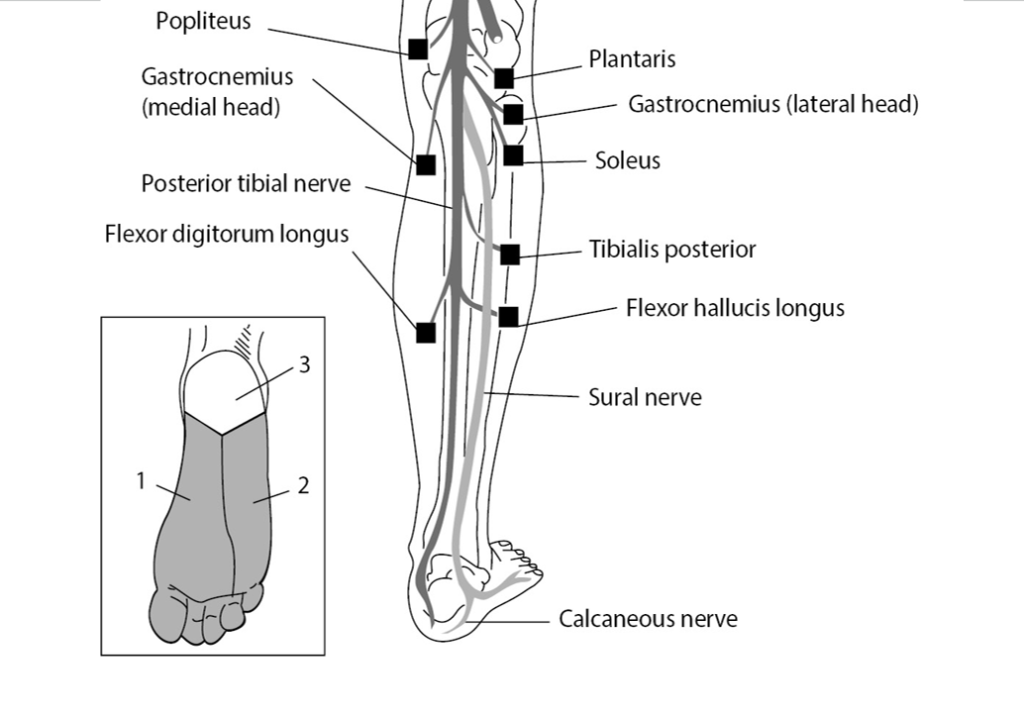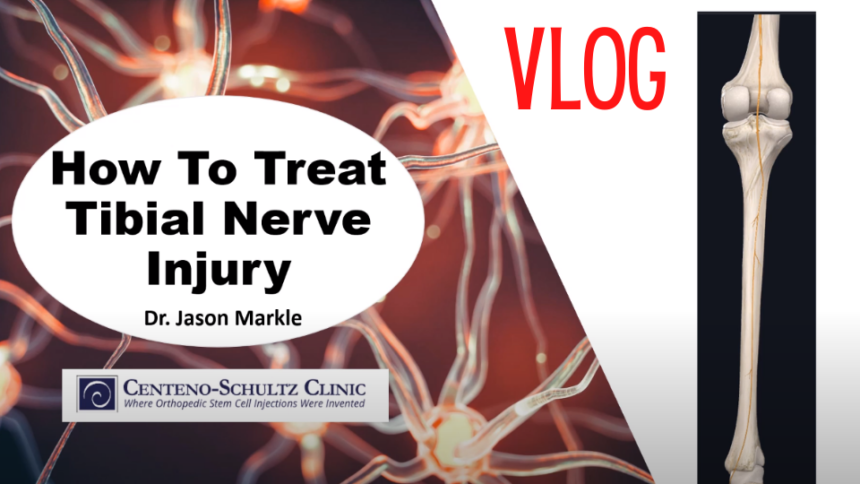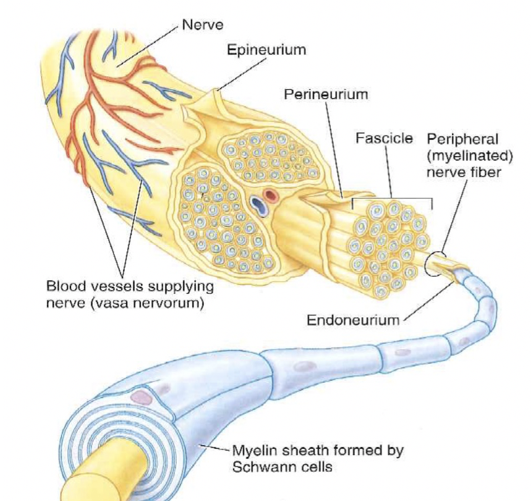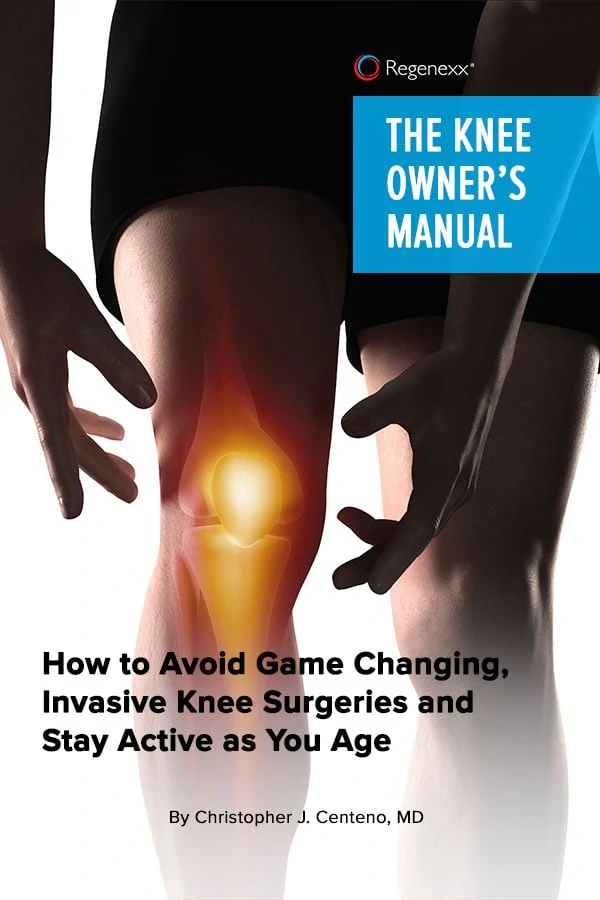Introduction
Today we’re going to be talking about how to treat tibial nerve injury. We’ll be discussing exactly what is the tibial nerve is, the muscles the tibial innervates, how the nerve can be injured, as well as potential treatments for this.
So let’s start off with what muscles are innervated by the tibial nerve. The tibial nerve is essentially an extension of your sciatic nerve. If you look on the right-hand side, this is your sciatic nerve, as it comes out of your hip, travels down at the back of the knee, it then splits.
One branch is in your common peroneal nerve and the other branch is your actual tibial nerve. That tibial nerve then goes down the back of the leg and goes, eventually, into the bottom of the foot.
So let’s take a closer look at this, and we can see all the muscles that the tibial nerve actually innervates, such as the
- Popliteus
- Plantaris
- Gastrocnemius, your
- Soleus, as well as your
- ankle, foot, and ankle muscles, such as your Post Tibialis, your Flexor Hallucis Longus, your Flexor Digitorum, your Posterior Tibial (See Figure 1, below)

Figure 1 – Nerves to be considered in Tibial Nerve Neuropathy
All of these muscles help move the ankle, such as plantar flexion, dorsiflexion, as well as supply some sensory innervations to the bottom of the foot.
What Is the Main Function of the Tibial Nerve?
As mentioned earlier, the tibial nerve innervates muscles as well as give sensations to the bottom of the feet. So if you damage that nerve, it creates some weakness in the leg, such as inability to plantar flex (basically go up on your toes, or even up on your heels), as well as wiggle your toes, flex your toes – all those become very weak. You can have a substantial amount of atrophy of those muscles. The Gastrocnemius becomes a lot of atrophy and loss of the muscle bulk, as well as the sensations – it creates a burning, numbness, and tingling on the bottom of your feet. This can be extremely problematic.
How Can the Tibial Nerves be Damaged?
The tibial nerve is commonly injured by trauma, so fractures.
If we look at this x-ray here, your tibial nerve runs right behind it. So this bone can damage and hit into that nerve, depending on how the fracture is situated, as well as if the fracture creates a lot of swelling. That swelling can create a lot of local compression. In other ways: it can be affected by systemic diseases, like diabetes mellitus. Diabetes creates a vascular injury around the nerves, which eventually leads to the denervation of the nerve, and nerve damage.
That nerve can also be damaged by a tumor, an abscess or also bleeding of the knee — anything that can create some local compression of the nerve and affect the function of the nerve.
How Can We Determine if the Tibial Nerve has been Damaged?
Based on history and physical examination. On that examination, we can typically see the inability of the patient to
- curl their toes,
- push down on the foot, or even
- twist the ankle inwards.
That weakness in the foot and ankle, as well as some atrophy in the leg muscles, gives a clue that the tibial nerve has been damaged.
We can do some further testing of the nerve, such as an electromyography or EMG, a nerve biopsy or nerve conduction test to see the electrical activity of the nerve. Alternatively, we can look at the appearance of the nerve on imaging, such as the diagnostic ultrasound or an MRI. A diagnostic ultrasound gives us the ability in real-time and in-clinic to really evaluate the nerve, the integrity of the nerve, as well as if there’s any swelling or compression of the nerve on the full length of the nerve.
Can the Nerve Damage be Repaired?
Let’s talk about what exactly is the nerve made of, how is it composed, and then different types of injuries. So, if you look on the left-hand side here, the nerve is essentially layers upon layers upon layers of different protective connective tissue, ultimately protecting the nerve fibers, which, actually, transmit the electrical signal. Around that is myelin, which is insulation. Around that is the Perineurium, more insulation. Around that would be the Epineurium. Supporting that are the blood vessels on the outside of the nerve. So all of these help protect the nerve.
Now, if the nerve has been damaged, there’s multiple different types of damage you can have.
You can damage:
- outer covering (called “Neurapraxia”)
- inner fibers of the nerve (the actual nerve itself, nerve fiber).
- complete severing of the nerve
Each one of these is a little bit more severe than the next, as well as sometimes there’s more of a combination of nerve injury, not just one specific type of nerve injury.
How Do You Treat a Tibial Nerve Injury?
The natural course of nerve regeneration typically is about a centimeter a month, or a millimeter a week. After that, after some time has passed if the nerve doesn’t naturally repair itself, there’s things we can interventionally do.
Some people that have a complete severing of their nerve do require surgery; they basically do what’s called the nerve graft. They take a donor nerve, connect the two ends of the nerve that have been severed and hope it sort of fills in and bridges the gap.
Today, in a lot of the Regenerative Medicine and Stem Cell Orthobiologic field, there’s been a lot of research over the last 10 years on nerve regeneration and use of Platelet-rich Plasma. There’s multiple different research studies showing fully transected nerves and sciatic nerve in a rat, where utilizing Platelet-rich Plasma has increased the rate of regeneration of the nerve, as well as the overall function of the nerve.
There’s also been multiple safety trials looking at carpal tunnel syndrome, which is the most common nerve injury in our peripheral nerves. That’s a chronic compressive neuropathy, which eventually leads to nerve damage, where you can put Platelet-rich Plasma around it.
There’s been three big randomised controlled trials, all showing efficacy of both the electrophysiological changes of the nerve improving as well as just the patient’s symptoms. So, patients avoid surgery with a simple nerve ultrasound-guided injection. If we look at the bottom left here, this is sort of how the procedure goes. We use an ultrasound to find the nerve. And then we bring the needle directly around and put the platelets in, surround the nerve, saturating the nerve with all the growth factors, helping the nerve to repair.
So, if you’ve been dealing with any tibial nerve pain or tibial nerve injury, considering surgery and or looking at alternatives to accelerate some of the regeneration of the nerves, we’re happy to discuss. Feel free to give us a call or you can reach out to us on one of our social media networks and we’re happy to discuss further. Have a good day.



